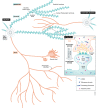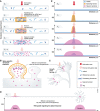Local translation in neuronal compartments: how local is local?
- PMID: 28404606
- PMCID: PMC5412868
- DOI: 10.15252/embr.201744045
Local translation in neuronal compartments: how local is local?
Abstract
Efficient neuronal function depends on the continued modulation of the local neuronal proteome. Local protein synthesis plays a central role in tuning the neuronal proteome at specific neuronal regions. Various aspects of translation such as the localization of translational machinery, spatial spread of the newly translated proteins, and their site of action are carried out in specialized neuronal subcompartments to result in a localized functional outcome. In this review, we focus on the various aspects of these local translation compartments such as size, biochemical and organelle composition, structural boundaries, and temporal dynamics. We also discuss the apparent absence of definitive components of translation in these local compartments and the emerging state-of-the-art tools that could help dissecting these conundrums in greater detail in the future.
Keywords: compartments; local translation; nascent protein; plasticity; spatial spread.
© 2017 The Authors.
Figures



References
Publication types
MeSH terms
Substances
LinkOut - more resources
Full Text Sources
Other Literature Sources

